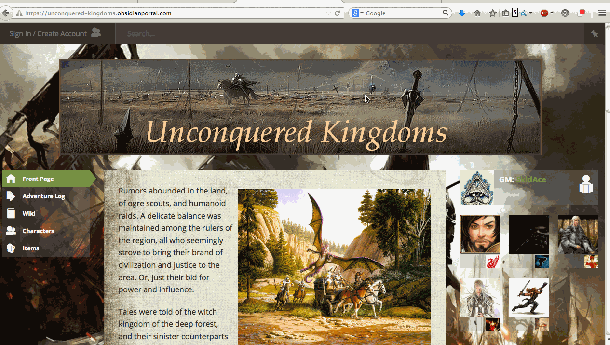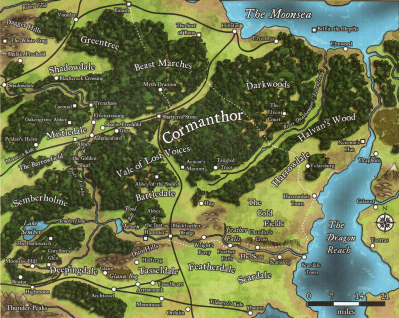Dear GMs, we’ve all been in that akward situation in which the players asks: “Are we back in that tiny village on the coast? Oh great, I want to come back at the fabolous “Inn of the Seagull”, the innkeeper was so kind! What was his name?” and that’s the exact moment in which you regret not to have a better organization for your notes. After this kind of questions two simple scenarios can occur:
- You pass the next 5-10 minutes leafing through your notes without success while your players keep saying “You know, it’s not that important let’s mov…” and you shout “NO NO, WAIT I CAN FIND IT!”. This is the bad scenario in case you’re wondering
- You just click on the right document or folder and then you answer with a pleased smile “He’s of course Bob, famous for his strawberry pie”
What I’m saying is that it’s 2014 (almost 2015) even for Pen-and-paper RPGs and that maybe we’ll soon call them Pen-and-paper-and-tablet-and-pc-and-smartphone RPGs. We all already use digital instruments for our favorite RPG when it comes at the books (legal or not), but I think that the matter of keeping your stuff well-organized as a GM is still an underrated problem. There are few GM tools strictly dedicated to RPGs you can use to organize the documents for your campaign, but some others can be easily adapted for such a purpose. Here are some of the ones I prefer (in no particular order), but this is not a complete list of course:
- Obsidian Portal – This is a great resource. By signing in you get: a complete Adventure Log in which you can keep track of your sessions, a Characters section, a Wiki and even a Calendar! It’s a great site and a great tool, but maybe it’s too much and sometimes you don’t want that level of detail. If you keep updating your site the result will be really great, but it depends on how much effort you put in it. If you like writing between the sessions it can be really a great tool for you and your players tohave fun with.

- Word processors (Libreoffice, Openoffice, MS Office, Google Docs, Emacs and so on…) – I’ve been doing this for more than five years and even if now I don’t do that any more I still think it’s quite a good method. I used to keep all the informations about my campaign in different folders opening the documents and updating them when needed. First let’s talk about the images. Let’s say your campaign starts at level 1 in a small village called “Vil”, you are very excited and you create a Folder called Campaign, with a Subfolder called “/Vil” and maybe two other subfolders called “/PCs” and “/Vil/NPCs”. Great! Now you have three folders and two of them are subfolders of a specific village. The first session occurs and after that you want to update your material: you add portraits of the NPCs, the map of Vil and a lot of more stuff that starts to fill your space. After three locations you will have three folders (let’s say Vil, Liv, and Ilv the three main towns of the Anagram Coast) which at least one subfolder. Why would you want to do that? Even if you are going to create a lot of folders (somewhat redundant) you do this extra work to keep your stuff cleaner, so that if your characters ask you who is the innkeeper at the Inn of the Seagull you don’t have to look inside a big NPCs folder with badly name files including every NPC of the campaign, you instead go to /Vil/NPCs and you can easily find the image you were looking for. This approach works better if you use a word processor for your stuff and then you create internal links which point at the images we talked about. In this scenario in your document (Let’s say Troubles at Bargewright.doc) you will have something like that (the links are broken, but they explain what I’m talking about):
Bargewright Inn
Menu:
- Roasted bear cooked with beer, bread and a glass of wine (3 sp)
- Deer stew with cardamom and a glass of red wine (1 sp)
- Roasted deer, a pint of beer (8 cp)
- White Dragon Carpaccio dressed with spices and lemon served with a glass of fine Cormanthot elvish wine (7 gp)
The inn is built around a small community in which these are the main figures:
Feston Bargewright – The innkeeper and head of the town. Neutral.
Aldon Bargewright – Head of the Militia, Neutral.
Chanczlatha Luruin – Cleric of Lathander and secretly an harper. Neutral Good.
In this way you keep your stuff clean and you can easily use a research (CTRL+F or CMD+F) to be ready to any question. This is great, but the complexity can diverge if you’re facing larger campaigns That’s whay I moved to the following tool.
- Scrivener Tool – This is the best tool I actually found on the internet who suits perfectly for an RPG campaign. The real purpose of this software is novel-writing, but it adapts incredibly well to pen-and-paper RPGs. The interface is very simple, you have a nice binder on the left in which you can easily navigate through any document you would ever need and it has a splittable screen that it’s really perfect for dungeon crawling (you can put the map in the upper window and the description of every room in the lower one). It’s a really simple and adaptable tool: here you can see a screenshot of the organization of my stuff for a SIRFP campaign (which is a very good RPG, I’ll talk about it in a future arcticle).

- Roll20 Journal – Maybe I shouldn’t include that because Roll20 it’a virtual tabletop and it’s built for online campaign (even if something is going to change), but I think it’s worth mentioning it. Roll20 has a great Journal sistem (you can read about it in the main link), which lets you create some Handouts with two different text entries: one for the players and another one who is GM-Only. The documents can be easily formatted and Archived to leave space to newer ones as they get older. This system is being improved and from their blog we read that they’re developing a feature to create folders and to speed up the whole journal section.
So, in the end, there are a lot of tools you can use and it really depends on the way you play. If I should choose one, I’d probably say Scrivener, but it’s because it suits perfectly for Sandboxing and that’s the kind of game I like the most.








